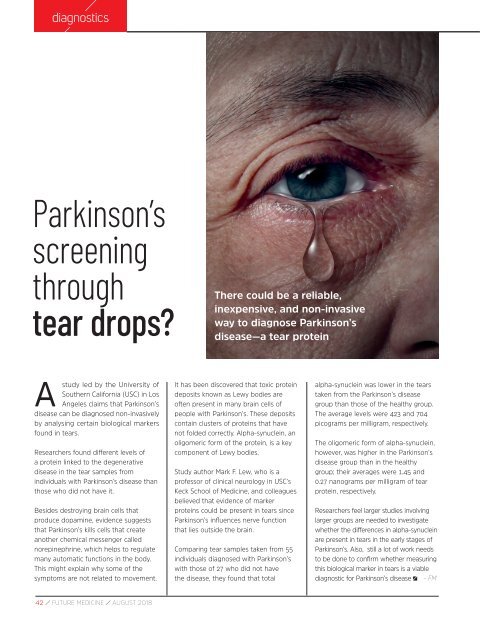FM AUGUST 2018 ISSUE1 - digital edition
You also want an ePaper? Increase the reach of your titles
YUMPU automatically turns print PDFs into web optimized ePapers that Google loves.
diagnostics<br />
Parkinson’s<br />
screening<br />
through<br />
tear drops?<br />
There could be a reliable,<br />
inexpensive, and non-invasive<br />
way to diagnose Parkinson’s<br />
disease—a tear protein<br />
A<br />
study led by the University of<br />
Southern California (USC) in Los<br />
Angeles claims that Parkinson’s<br />
disease can be diagnosed non-invasively<br />
by analysing certain biological markers<br />
found in tears.<br />
Researchers found different levels of<br />
a protein linked to the degenerative<br />
disease in the tear samples from<br />
individuals with Parkinson’s disease than<br />
those who did not have it.<br />
Besides destroying brain cells that<br />
produce dopamine, evidence suggests<br />
that Parkinson’s kills cells that create<br />
another chemical messenger called<br />
norepinephrine, which helps to regulate<br />
many automatic functions in the body.<br />
This might explain why some of the<br />
symptoms are not related to movement.<br />
It has been discovered that toxic protein<br />
deposits known as Lewy bodies are<br />
often present in many brain cells of<br />
people with Parkinson’s. These deposits<br />
contain clusters of proteins that have<br />
not folded correctly. Alpha-synuclein, an<br />
oligomeric form of the protein, is a key<br />
component of Lewy bodies.<br />
Study author Mark F. Lew, who is a<br />
professor of clinical neurology in USC’s<br />
Keck School of Medicine, and colleagues<br />
believed that evidence of marker<br />
proteins could be present in tears since<br />
Parkinson’s influences nerve function<br />
that lies outside the brain.<br />
Comparing tear samples taken from 55<br />
individuals diagnosed with Parkinson’s<br />
with those of 27 who did not have<br />
the disease, they found that total<br />
alpha-synuclein was lower in the tears<br />
taken from the Parkinson’s disease<br />
group than those of the healthy group.<br />
The average levels were 423 and 704<br />
picograms per milligram, respectively.<br />
The oligomeric form of alpha-synuclein,<br />
however, was higher in the Parkinson’s<br />
disease group than in the healthy<br />
group; their averages were 1.45 and<br />
0.27 nanograms per milligram of tear<br />
protein, respectively.<br />
Researchers feel larger studies involving<br />
larger groups are needed to investigate<br />
whether the differences in alpha-synuclein<br />
are present in tears in the early stages of<br />
Parkinson’s. Also, still a lot of work needs<br />
to be done to confirm whether measuring<br />
this biological marker in tears is a viable<br />
diagnostic for Parkinson’s disease - <strong>FM</strong><br />
42 / FUTURE MEDICINE / <strong>AUGUST</strong> <strong>2018</strong>


















